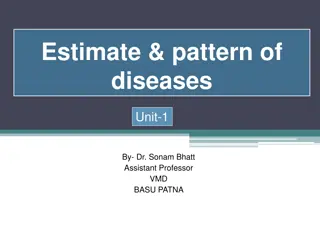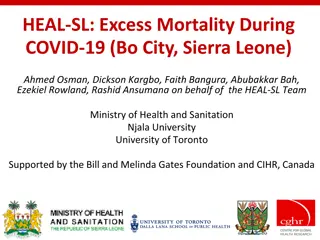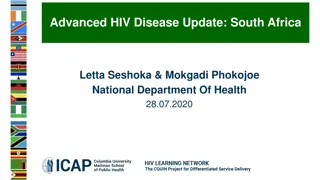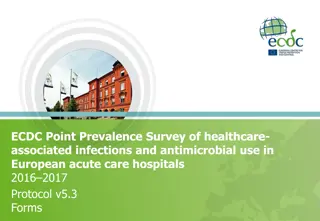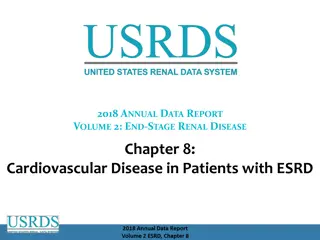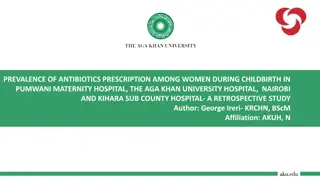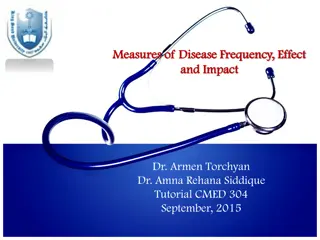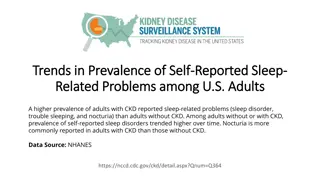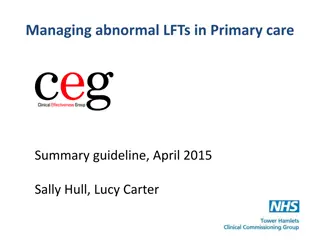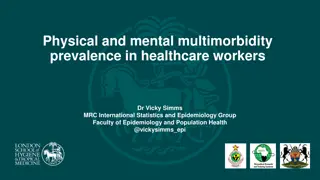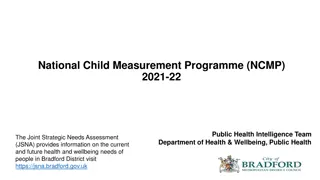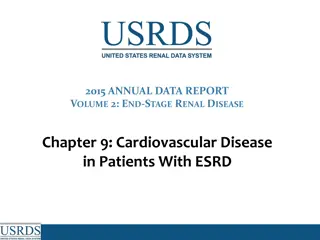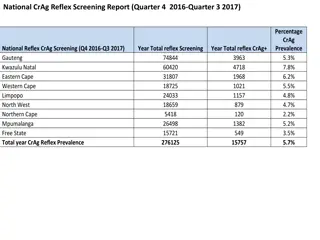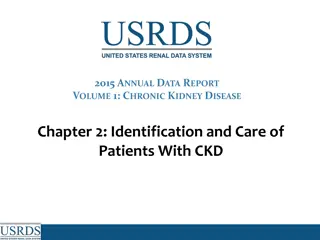Understanding Steatotic Liver Disease: Importance, Epidemiology, and Pathology
Steatotic liver disease, including metabolic dysfunction associated steatohepatitis (MASLD) and metabolic associated alcoholic liver disease (MALD), is a common cause of liver test abnormalities in the United States. Risk factors such as obesity and metabolic syndrome can lead to advanced fibrosis a
2 views • 44 slides
Innovations in Infectious Disease Control: Insights from Experts
Explore the latest advancements in infectious disease control through the lens of renowned epidemiologists and researchers. Delve into the impact of the COVID-19 pandemic, the historical prevalence of infectious diseases, and early infection prevention practices. Uncover the evolution of infectious
0 views • 22 slides
Understanding the Natural History of Disease Development and Prevention
The natural history of disease development outlines the progression of a disease in an individual without intervention, from exposure to outcome. Learning objectives include defining prevention terms, understanding disease severity, prevention levels, and intervention measures. Studying disease prog
4 views • 16 slides
Principles of Epidemiology: Understanding Disease Occurrence and Surveillance
Epidemiology is the study of disease patterns, factors influencing disease occurrence, and the core functions of surveillance, field investigation, and analytic studies. It involves understanding disease characteristics, natural history, and evaluating the effectiveness of activities to mitigate dis
1 views • 25 slides
Autoimmunity Screening for Kids (ASK) Study Findings in Colorado Population
Autoimmunity Screening for Kids (ASK) conducted a study in Colorado on over 30,000 children aged 1-17, revealing a 1.0% prevalence of pre-symptomatic Type 1 Diabetes (T1D) and a 2.1% prevalence of celiac disease/autoimmunity. The screening showed a significant reduction in Diabetic Ketoacidosis (DKA
1 views • 15 slides
Update on Advanced HIV Disease in Zambia: Prof. Lloyd Mulenga Shares Insights
Prof. Lloyd Mulenga, Director for Infectious Disease at the Ministry of Health in Zambia, provided an update on Advanced HIV Disease (AHD) in the country. The update includes progress towards the 95-95-95 target, prevalence of AHD, mortality rates among PLHIV, coordination of AHD services at the nat
2 views • 16 slides
Arthritis Prevalence in New York Among General Adult Population and Those with Chronic Disease Risk Factors
The statistics present the prevalence of arthritis among adults in the United States, with a focus on New York. Over 52.5 million adults in the US have been diagnosed with various forms of arthritis. The data includes information on risk factors such as being overweight, obese, physically inactive,
0 views • 22 slides
Insights into Tyzzer's Disease: An Overview of a Bacterial Infection in Laboratory Animals
Tyzzer's disease is an acute bacterial infection affecting rodents and rabbits, caused by Clostridium piliforme. Discovered in 1917 by Ernest Tyzzer, the disease is characterized by necrotic lesions in the caecal mucosa, liver, and heart. Initially known as Bacillus piliformis, it was later renamed
2 views • 21 slides
Prevalence and Risk Factors of Chlamydia Trachomatis in Women Across Fiji Clinics
This study focuses on identifying the prevalence and risk factors of sexually transmitted Chlamydia trachomatis in women across rural and urban clinics in Fiji. It reveals a significant prevalence of the infection, with variations based on ethnicity, location, and age groups. The findings underscore
0 views • 5 slides
Understanding Disease Patterns in Epidemiology: Overview and Examples
Epidemiology is the study of health event distribution in populations. This includes analyzing disease patterns by time, place, and affected individuals. Diseases can be sporadic, endemic, epidemic, or pandemic, each with distinct occurrence characteristics. Understanding disease prevalence and inci
0 views • 9 slides
Understanding Disease Control and Prevention in Epidemiology
This article discusses disease control processes in epidemiology, including reducing disease incidence, duration, and transmission. It covers public policy interventions, elimination, eradication, and extinction of infectious agents. It also highlights preventable causes of disease and different lev
2 views • 10 slides
Insights on Excess Mortality and COVID-19 Prevalence in Bo City, Sierra Leone
Study by the HEAL-SL team examines excess mortality during the COVID-19 pandemic in Bo City, Sierra Leone. Findings suggest potential underreporting of COVID-related deaths and highlight the importance of seroprevalence studies in understanding the impact of the virus. The research includes analysis
6 views • 14 slides
Update on Advanced HIV Disease in South Africa
Update on advanced HIV disease in South Africa highlights progress in reducing AIDS-related deaths, prevalence rates, and advancements in coordinating and implementing policies and guidelines for HIV/AIDS response. The report covers statistics on HIV prevalence, ART facilities, mortality rates, and
0 views • 17 slides
ECDC Point Prevalence Survey of Healthcare-associated Infections and Antimicrobial Use in European Acute Care Hospitals 2016-2017 Protocol v5.3 Forms
This protocol outlines the data collection form for the ECDC Point Prevalence Survey focusing on healthcare-associated infections and antimicrobial use in European acute care hospitals during 2016-2017. The detailed form covers various aspects such as hospital information, infection control measures
0 views • 8 slides
Dealing with Disease in Early Modern Britain
Explore the methods of treating disease in Early Modern Britain, including advancements in surgery by Ambroise Pare and Andreas Vesalius, the prevalence of quackery in medicine sales, and the impact of individuals like Lady Johanna St. John and Nicholas Culpeper. Evaluate the effectiveness of diseas
0 views • 8 slides
Screening for Peripheral Vascular Disease in Patients with Coronary Artery Disease
Patients with coronary artery disease should be screened for peripheral vascular disease as it is a frequent integrator of global cardiovascular risk. The association of atherosclerosis in various arterial diseases highlights the importance of identifying multisite artery disease. The prevalence and
0 views • 23 slides
Prevalence of Cardiovascular Disease in Adult ESRD Patients: 2016 Data Report
The data report examines the prevalence of cardiovascular diseases in adult End-Stage Renal Disease (ESRD) patients in 2016 by treatment modality and age. It includes information on various cardiovascular conditions such as atrial fibrillation, acute myocardial infarction, coronary artery disease, a
2 views • 25 slides
Human Disease Symptom Network: Understanding Disease Relationships Through Symptoms and Genes
The Human Disease Symptom Network (HSDN) is constructed using a large-scale medical bibliographic records database to form a network of human diseases based on symptom similarities. By integrating disease-gene associations and protein-protein interaction data, correlations between symptom similarity
0 views • 37 slides
Prevalence of Antibiotics Prescription Among Women During Childbirth: A Retrospective Study
This retrospective study aimed to define the prevalence and types of antibiotics prescribed, timing, and duration of prescription for mothers during childbirth at Pumwani Maternity Hospital, The Aga Khan University Hospital in Nairobi, and Kihara Sub-County Hospital. The study focused on determining
0 views • 9 slides
Understanding Bacterial Diseases of Fish: Columnaris Disease Overview
Columnaris disease, also known as Saddleback disease, is a common bacterial infection in fish that is often brought about by poor handling and high stress levels. This disease manifests as tail and fin rot, leading to rapid fish mortality. The causative organism, Cytophaga (formerly Flexibacter), is
0 views • 21 slides
Decline of Hepatitis C in England: 2022 Report Highlights
The 2022 report on Hepatitis C in England shows a continued decline in the prevalence of chronic HCV infection, with around 81,000 individuals estimated to be affected in 2020. The report also highlights the distribution of infections among individuals with different drug injecting histories. Data f
0 views • 41 slides
Prevalence of Alcohol, Tobacco, and Drug Use Among School-Aged Children in Algeria
This study presented at the Lisbon Addictions 2017 conference discusses the prevalence of alcohol, tobacco, and drug use among school-aged children in Algeria, highlighting legal, social, and economic factors influencing the use. The data sources and statistics on drug prevalence use in Algeria, as
0 views • 8 slides
Understanding Disease Frequency and Impact Measures
This informational resource delves into various aspects of disease frequency, effect measures, and impact, covering key terms like exposure and disease. It also discusses important measures like incidence rate, prevalence rate, and risk difference. Examination questions related to the incidence and
0 views • 16 slides
Prevalence of HIV and STIs among Female Sex Workers in Moscow
Study conducted in Moscow, Russia among female sex workers revealed a high prevalence of HIV and other STIs, particularly among outdoor workers. Findings indicate challenges such as difficult access to condoms, inconsistent condom use, low HIV testing rates, and high rates of sexual violence. The HI
0 views • 6 slides
Trends in Prevalence of Self-Reported Sleep Problems among U.S. Adults with and without CKD
A study on the trends in self-reported sleep-related problems among U.S. adults, particularly those with Chronic Kidney Disease (CKD). The findings indicate a higher prevalence of sleep disorders, trouble sleeping, and nocturia in adults with CKD compared to those without CKD. The data suggests that
0 views • 4 slides
Understanding Quantitative Genetics of Disease - Part 2
This content delves into the quantitative genetics of disease, exploring concepts like liability threshold models, phenotypic liabilities, normality assumptions, and genetic factors' contribution to disease variance. It examines how disease prevalence and heritability correlate with affected individ
0 views • 24 slides
Decoding Genetics: Insights from Alzheimer's Disease Symposium to Type 2 Diabetes Study
Explore the latest findings from the Alzheimer's Disease Genetics Symposium 2019 on disease mechanisms, drug targets, and genetic pathways. Dive into the progress made by the Alzheimer's Disease Genetics Consortium over the past decade. Transition to a Genome-Wide Association Study uncovering suscep
0 views • 42 slides
Managing Abnormal Liver Function Tests in Primary Care: Summary Guideline
Guideline drafted by Dr. Sally Hull and Dr. Lucy Carter focuses on identifying patients at risk of chronic liver disease, increasing testing for treatable liver conditions, and auditing prevalence of major liver diseases. The importance of diagnosing Non-Alcoholic Fatty Liver Disease (NAFLD) and str
0 views • 23 slides
Liver Disease Burden in Tower Hamlets
Dr. Somen Banerjee, Director of Public Health in London Borough Tower Hamlets, highlights the concerning liver disease mortality rates in the area, with high incidence of cirrhosis, cancer, and hepatitis B and C. The data reveals a significant burden of liver diseases such as Non-Alcoholic Fatty Liv
0 views • 18 slides
Comprehensive Management Tips for Lyme Disease by Raj Patel, M.D. & Susan McCamish, Herbalist
Raj Patel, M.D., along with herbalist Susan McCamish, provides valuable insights on Lyme disease management. The presentation covers aspects such as Jarisch-Herxheimer Reaction, prevalence, symptoms, treatment protocols, and immune response variability. Dr. Patel emphasizes assessing, supporting key
0 views • 48 slides
Understanding Inflammatory Bowel Disease: Crohn's Disease and Ulcerative Colitis
Inflammatory Bowel Disease (IBD) encompasses Crohn's disease (CD) and ulcerative colitis (UC), chronic conditions with immunologic basis. This article delves into the epidemiology, pathophysiology, and differences between CD and UC, highlighting clinical features, pathology, and complications like a
0 views • 42 slides
Prevalence of Physical and Mental Multimorbidity in Healthcare Workers
This study by Dr. Vicky Simms explores the prevalence of physical and mental multimorbidity among healthcare workers, focusing on conditions such as diabetes, hypertension, HIV, depression, and anxiety. Data from occupational health screenings, client characteristics, condition definitions, enrolmen
0 views • 14 slides
Prevalence of Intestinal Helminths in Comprehensive High School, Ilese-Ijebu, Ogun State, Nigeria
Infestation by intestinal helminths poses a significant public health issue, impacting school-age children with chronic anaemia, growth stunting, malnutrition, fatigue, and cognitive impairments. The study aims to investigate the prevalence of intestinal helminths in a Comprehensive High School in I
0 views • 14 slides
Child Obesity Trends in Bradford District: NCMP 2021-22 Report
The National Child Measurement Programme (NCMP) data for 2021-22 in Bradford District shows concerning trends in child obesity. The prevalence of excess weight in reception-aged children has increased to 23.2%, surpassing the England average. Similarly, in Year 6 children, the prevalence of excess w
0 views • 16 slides
Ultrastructural Alterations of Renal Tissue in a Male Patient with Fabry's Disease
Fabry's disease is a rare X-linked lipid storage disorder characterized by deficient lysosomal alpha-galactosidase A activity. This condition primarily affects males, leading to chronic kidney disease and progression to end-stage renal disease. Kidney involvement is a critical aspect, and high doses
0 views • 24 slides
Cardiovascular Disease in End-Stage Renal Disease Patients: Data Analysis 2011-2013
Understanding the prevalence and causes of cardiovascular diseases in patients with End-Stage Renal Disease (ESRD) is crucial for effective management. This report analyzes data from 2011-2013, focusing on the causes of death in ESRD patients, prevalence of cardiovascular diseases by treatment modal
0 views • 18 slides
Understanding Palliative Care and Self-Directed Death in Canadian Federal Prisons
Analyzing the need for palliative care and self-directed death among incarcerated individuals in Canadian federal prisons, this study explores key demographics, disease prevalence, mortality rates, and challenges in obtaining parole. With an aging prison population and higher disease prevalence comp
0 views • 51 slides
National CrAg Reflex Screening Report (Q4 2016-Q3 2017) - Prevalence and Trends
The National CrAg Reflex Screening Report from Quarter 4 of 2016 to Quarter 3 of 2017 reveals the percentage CrAg prevalence across different provinces in South Africa. Gauteng had the highest reflex screening numbers, while Kwazulu Natal showed fluctuating trends. The overall prevalence ranged from
0 views • 12 slides
Understanding Viral Pathogenesis: Causes and Consequences
Viral pathogenesis involves the process by which a virus leads to disease, exploring the interplay between viral and host factors. It encompasses the concepts of virulence, viral disease, and the effects on infected cells and the host's immune response. Changes within infected cells, including cell
0 views • 26 slides
Chronic Kidney Disease: Prevalence and Comorbid Conditions Among Medicare Patients
The data report presents information on the identification, care, and prevalence of Chronic Kidney Disease (CKD) among Medicare patients aged 65 and above in 2013. It includes tables showing the ICD-9-CM codes for CKD stages, prevalence of coded comorbid conditions (CKD, CVD, DM), demographic charac
0 views • 15 slides









